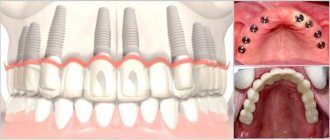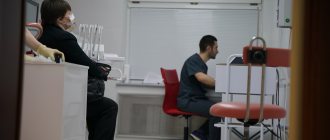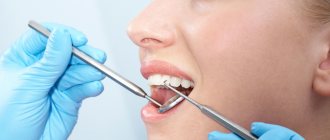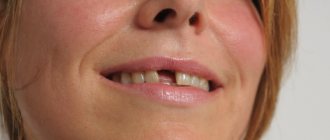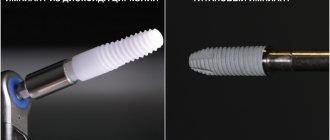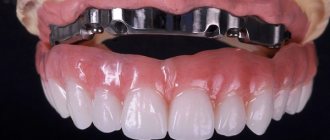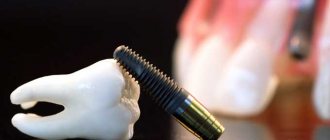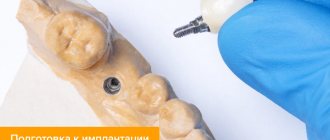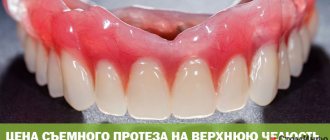From this article you will learn:
- How is prosthetics performed on implants?
- terms of prosthetics,
- options for fixed and removable prosthetics.
Prosthetics on implants is the final stage of the dental implantation procedure, but nevertheless, mistakes made at this stage can easily undo the success achieved during the surgical stage of implantation. As a result, already 1-2 years after installing a crown on a dental implant, inflammation may develop around it, accompanied by pathological resorption of bone tissue. As a result, the patient may end up with an unsatisfactory appearance of the gums around the implant neck, exposure of the metal neck of the implant due to gum recession, etc.
And if you contact your dentist with such problems, of course, no dentist will connect all this with poor-quality prosthetics. The dentist will tell you about the characteristics of your body, and that nothing can be guaranteed. But none of this is true. If, at the time of starting prosthetics, you had achieved excellent integration of the implant into the bone tissue, then the causes of all subsequent complications (subject to good oral hygiene) should be sought precisely in poorly performed prosthetics.
Options for prosthetics on dental implants –
There are special devices that allow you to check the quality of implant integration/stability of the implant in bone tissue (for example, Periotest M). The measurement is carried out before the start of prosthetics, and we will clearly evaluate the quality of the surgical stage in numbers. In the future, this will make it possible to determine who is ultimately to blame for the complications that arise after prosthetics (the implant surgeon or the prosthetist and dental technician). If we are talking about immediate prosthetics immediately after installing the implant, then we will see whether its primary stability is sufficient for us to immediately put an immediate load on the implant.
Testing the stability of the implant before starting prosthetics will help avoid many complications. After all, when a crown is installed on an implant, it immediately begins to experience chewing load. If the osseointegration of the implant is weak, then the chewing load can lead to pathological bone resorption around the implant and gum problems. If the device shows poor integration of the implant, this will be a signal to the doctor that it is necessary to delay the start of prosthetics for another few weeks or a month.
Features of dental prosthetics on implants
Jaw prosthetics on implants can be either removable or non-removable. The choice of technology is based on the individual characteristics of the clinical picture of the patient’s oral cavity. So, with partial edentia, it is possible to carry out exclusively permanent prosthetics on implants, which involves installing crowns and bridge-type prostheses on the implanted implants.
If the patient has complete edentia, the option of removable prosthetics on implants is possible, which is more correctly called conditionally removable, since the patient will not be able to remove the installed prosthesis on his own, so strong will be its fixation in the oral cavity. The price of prosthetics on implants in Moscow cannot be called cheap - this is an expensive dental procedure, and therefore you should become familiar with all its stages before contacting a specific clinic. Knowing the specifics of the process will protect you from poor-quality prosthetics and contacting specialists who are incompetent in this area.
Who can undergo implantation and who cannot?
Implants cannot be installed in girls under eighteen years of age, and in boys under twenty-one years of age, since during this period the bone is still forming, and implantation can disrupt this complex process. As for the upper age limit, there is no upper age limit for installing implants. Absolute contraindications include disorders of blood clotting and bone regeneration. It is prohibited to perform the operation on pregnant women and people with an unbalanced psyche. In all other cases, implantation is possible.
Stages of prosthetics on implants
For implant-supported prosthetics to be effective, a specialist must draw up a complete and detailed plan for all manipulations. First, the patient is examined during which an impression is taken of his teeth. The doctor does this with a special instrument - an articulator. Based on the impression, two models of the future prosthesis will be made in the laboratory: laboratory and surgical.
Prosthetics on implants
from 22950 rub. More about prices
We have been working since 1994
we are one of the first to open private dentistry in Moscow
Best materials
only new and modern equipment for dental treatment
Free
consultation with a dentist
Payment options
- cash
- plastic cards
- cashless payments
Doctors' experience
- with great experience
- graduated
- conference participants
An accurate surgical model of a prosthesis on implants is needed to correctly select the type of surgical intervention that will be used to implant the implant into the bone. One or another technique is selected taking into account a number of parameters: the volume of bone tissue, its condition, the position of the implants, and the characteristics of the bite. In modern dentistry, three main technologies for complete prosthetics on implants are used:
1. Standard one-stage implantation. It uses a special type of implants that do not require additional protection from loads. The technique is quite gentle, since it eliminates suturing of the soft tissues of the oral cavity.
2. One-stage implantation with urgent or non-urgent prosthetics. The first option is applicable if the patient has sufficient bone tissue density.
3. Two-stage prosthetics on implants, in which the implant itself is first implanted, and then the soft tissues are sutured. This manipulation allows you to minimize the load on the tissue in the area of prosthetics for the entire healing period.
Which method of complete dental prosthetics on implants will be optimal - this question can only be answered by a qualified implantologist. Visit our dentistry in Moscow - Vanstom - and receive detailed information on implantation technologies, as well as the cost of prosthetics on implants.
Exceptional moments
There are cases when, before prosthetics, the doctor unscrews the screw or abutment, and the pin rotates along with it. This indicates that fibrous tissue has grown between the implant and the bone, which means there is no contact fusion. In 99% of cases, the cause of the process is incorrect installation of the base.
For example, at the preparatory stage the bone bed overheated or before installation the implant came into contact with the oral mucosa - this triggered the development of a bacterial process. There are many reasons, but there is only one way out - to carry out the operation again!
Options for implant prosthetics
The cost of dental prosthetics on implants will depend both on the choice of surgical intervention technology and on the type of prosthesis. Let's look at the main types of prostheses used in the procedure.
Prosthesis on implants, fixed by cementation
This design option is suitable for both removable and non-removable dental prosthetics on implants. The restoration procedure using such a prosthesis is relatively simple and gives good results, both in terms of functionality and aesthetics. However, there is also a minus: the design is fixed in the mouth so firmly that if complications arise, it will not be easy to remove it.
Implantation options for small defects in the upper dentition
In the absence of 1-3 consecutive teeth, patients are recommended to receive classical implantation. This is the only technique that allows you to work in a limited volume of bone.
The procedure is carried out in two stages:
- At the first stage, the doctor peels off the gum flap and forms a bed in the bone with a special tool, in which he places the root part of the implant. The gum is sutured. Next, the doctor and patient wait 3-4 months for the structure to take root—during this time, bone cells penetrate the pores of the implant and literally fuse with it.
- In the second stage, the gums are reopened. A gum former is installed on the artificial root, which helps create a beautiful contour of the soft tissue around the neck of the implant. After 2 weeks, the former is replaced with a supragingival head (abutment), on which the crown is fixed.
In total, classical dental implantation in the upper jaw takes about six months.
Important note: if the results of the examination reveal that the patient has bone atrophy, he undergoes an additional procedure before implantation - bone grafting. As a rule, after such an operation, another 3-6 months must pass before the bone volume is restored and becomes suitable for the installation of implants.
Cast prosthesis with screw fixation
The use of this type of prosthesis on implants will be most justified if there is a significant distance between the dental units. To fix the prosthesis, screw elements are screwed into the implants and pass through it. The advantages of this option are that, if necessary, the prosthesis can be removed simply and quickly, and the design itself looks aesthetically pleasing. There is one significant drawback - this type of prosthetics on implants does not always allow for the creation of a correct and uniform distribution of the chewing load.
Early load
This type involves the installation of a crown or bridge after 2-6 weeks. Despite the correctly selected prosthesis and obtaining optimal primary stability during attachment, there is a high risk of traumatic bone resorption, which begins within 2-3 days after manipulation. The process lasts on average 2 weeks and destabilizes the prosthesis. The ultra-hydrophilic surface of implants in combination with surface treatment with active substances (phosphates or fluoride ions) will help reduce the harmful effects.
This method is used when one front tooth is lost to restore aesthetics.
Standard prosthesis with screw fixation
This type of prosthesis can be fixed with special locks or clips. For its installation in the area of the lower jaw, it will be necessary to implant at least four implants; prosthetics of the upper jaw on implants with this type of structure will require the implantation of a larger number of implants - up to 10. Accordingly, the price of prosthetics on implants in this case will increase significantly.
Note that the type of structures under consideration is used for the installation of bridges even when the patient has significant atrophy of bone tissue or significant thickness of the gums. The key advantage of this type is that the patient, if necessary, can remove such a prosthesis himself without visiting the dentist’s office.
Do I need to follow certain rules after surgery?
After the procedure, you must follow all the specialist’s recommendations. In the first two to three days, you should not rinse your mouth in the area of the implant, since blood cells that promote its healing are washed out from the operated area. However, it is still necessary to clean the implant installation area, although very carefully. To do this, you can use special brushes with soft bristles and a paste with an antiseptic effect. For three to four days after the operation, you should not exercise, carry weights, or visit a sauna, bathhouse or solarium. And - most importantly - if any unpleasant or abnormal sensations occur, you must immediately contact your dentist. If you carefully care for the implant and follow all recommendations, it will last you a lifetime.
Dental prosthetics on implants: reviews and prices
You can read different reviews about dental prosthetics on implants, and such a range of opinions is explained by the fact that, wanting to save money, people turn to clinics that have neither specialists competent in implantation issues nor the necessary equipment. Hence the negative reviews about negative consequences, complications, and implant rejection.
It is important to understand that removable and, especially, fixed prosthetics on implants cannot cost a penny: this technology is complex, requiring the use of expensive materials, specific tools and all manipulations performed by a highly qualified specialist. Therefore, you should carefully and carefully select a clinic and a doctor who will perform the prosthetic procedure on implants.
If you are interested in high-quality prosthetics on implants in Moscow, visit our Vanstom dentistry. We do not lure patients with beautiful but false advertising and offer services of European quality at their real cost.
Expert opinion
Vladimir Aleksandrovich Voznyuk
maxillofacial surgeon, implantologist
Experience: more than 33 years
In whatever area of the upper jaw a “gap” is formed - frontal, lateral or chewing - a negative impact on the body is inevitable. The fact that the absence of a tooth is not noticeable from the outside is not an argument in favor of refusing restoration. Decreased quality of chewing function, malocclusion, increased load on neighboring teeth, and as a result - their rapid destruction - these are just some of the problems that will become obvious in the near future. Implantation of teeth in the upper jaw will stop bone atrophy, ensure normal chewing and consumption of any usual food, and prevent early aging of the face. When planning implantation, it is important to choose a reliable clinic and specialist who will individualize the approach to the problem and propose a protocol that is optimal for you.
Prosthetics on implants: price
| — Restoration of the dentition using 1 unit of metal-ceramic crown on an implant | 12000 rub. |
| — Dental restoration using 1 unit of crown per implant (CEREC) | 24500 rub. |
| — Restoration of the dentition using 1 unit of ceramic crown per implant (Empress) | 20,000 rub. |
| — Installation of abutment | 2250 rub. |
| — Using the Astra Tech abutment | 13000 rub. |
| — Use of Astra Tech cerconium oxide abutment | 15,000 rub. |
| — Use of implantium abutment | 6000 rub. |
| — Using an angled Implantium abutment | 8000 rub. |
| — Use of special Implantium abutment | 11000 rub. |
| — Transfer installation | 1000 rub. |
| — Taking a single-layer impression and casting a non-separable model | 300 rub. |
| — Taking a two-layer impression and casting a collapsible model | 800 rub. |
| — Fixation of the crown with glass ionomer cement, composite | 600 rub. |
| — Fixation of the crown with double-curing cement | 800 rub. |
View price list
